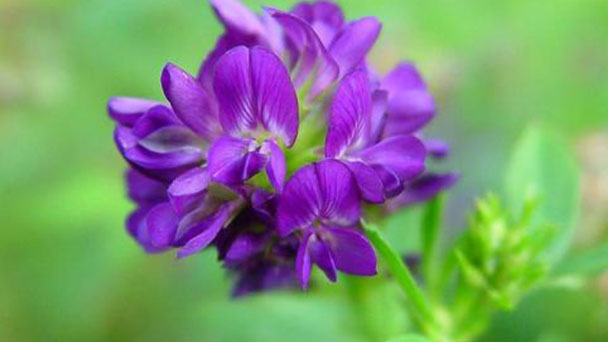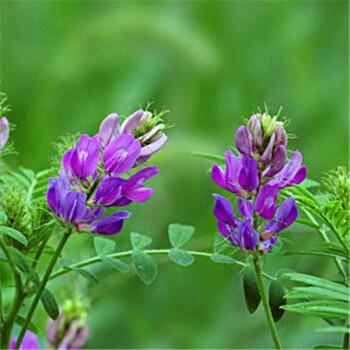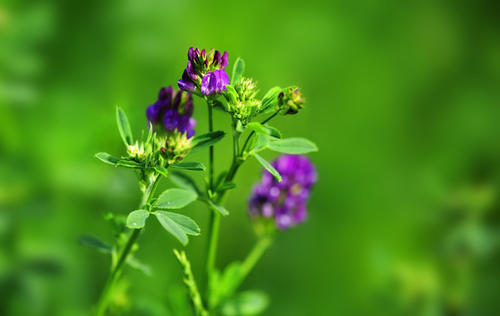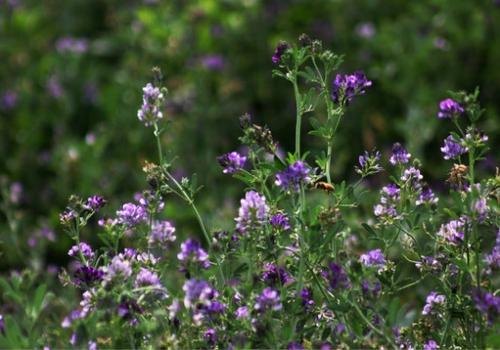How to grow and care for Alfalfa
Written by Maggie
Jan 25 2021

Alfalfa (scientific name: Medicago sativa), is a leguminous plant.With its high yield and excellent grass quality, it has become one of the most widely distributed and best quality forages in the world, and has been cultivated in China for more than two thousand years. Let's learn about the growing methods of Alfalfa and how to care for Alfalfa.

Growing method of Alfalfa
1. Preparation for growing Alfalfa
Before growing, Alfalfa seeds with good quality must be selected. Generally speaking, Alfalfa seeds such as Liangmu No. 5, Saite, Suntory, Debao and Defu are mainly used.
Seeds and soil should be properly treated before growing Alfalfa. The treatment of uncoated seeds mainly includes insecticide, sterilization, inoculation of rhizobia and so on. Soil treatment mainly includes ploughing, fertilization, weeding and insect killing.
2. Seed treatment before growing Alfalfa
The seeds of Alfalfa for growing are dormant and have a high hard seed rate. Therefore, before growing Alfalfa, it should be used to rub seed coat method or hot water immersion method for treatment. The method of hot water immersion is to soak the seeds of Alfalfa in water at 50-60℃ for 30min, take them out and dry them and sow them. The germination rate of seeds can be greatly increased by seed treatment. In addition, the plots for the first planting of Alfalfa should be seeded with a rhizobia agent. Generally, each kg of seeds with Rhizobium agent 5G, fully mixed immediately after sowing. Alfalfa inoculated with bacteria has strong nitrogen fixation ability, vigorous growth and high yield.
3. Growing method of Alfalfa: sowing
There are several methods of sowing in spring, summer, autumn and wintertime.
Spring sowing growing method of Alfalfa: we can use the soil moisture after the early spring thaw, in the ground temperature stability to reach the germination temperature, immediately seize the soil moisture sowing. Special attention should be paid to weed control in spring sowing.
Summer sowing growing method of Alfalfa: generally in June to July. At this time the environment for growing Alfalfa is suitable, after sowing seedlings quickly, but because at this time more weeds, diseases and insect pests are also much, and often high temperature burn, affect seedling growth. In alpine regions, summer sowing is often delayed due to spring drought and other reasons.
Autumn sowing is the best time for Alfalfa growing, which is usually carried out between September and October, when all kinds of environmental conditions are suitable.
Sowing seeds at Winterfall is a special time for Alfalfa planting in the north. The practice is to plant seeds before winter, when they have frozen during the night and can thaw during the day. After sowing because of the low temperature, the seeds can not germinate, to the early spring of the second year, the weather warmer, the thaw, the seeds began to germinate seedlings, seedlings neat and robust.
The growing of Alfalfa varies slightly in different places due to its different natural conditions, sowing methods and utilization purposes. Increasing the sowing amount can increase the yield of the first year, but it is not conducive to increase the yield of the following years, so the sowing amount should be controlled in an appropriate range, and should not be too high.

Alfalfa care for growing Alfalfa
Weeding care
After sowing to seedling period, every year after turning green, after each cut should pay attention to weed control. Manual removal or chemical weeding can be used. When we grow and care for Alfalfa, chemical weed control can be sprayed with Alfalfa special herbicide, and note that it is forbidden within 14 days before cutting.
Fertilizing care
Alfalfa has nodules, which can fix nitrogen in the air and provide nitrogen for itself. Therefore, when we grow and care for Alfalfa, phosphorus fertilizer should be applied mainly, and potassium fertilizer should be applied appropriately. But in barren wasteland, saline-alkali land, the soil nitrogen content is low, we should apply certain urea to do seed fertilizer when sowing. In the seedling stage or after annual greening, root nitrogen fixation ability of Alfalfa is weak, and topdressing of a certain amount of nitrogen fertilizer can increase its yield.
Water care
Alfalfa roots are deep into the soil, drought resistance. However, in dry season and timely watering after each cutting, the yield can be significantly increased. Alfalfa root system is not tolerant to flooding, and continuous flooding for 24h will lead to death. Therefore, when we grow and care for Alfalfa, timely drainage should be paid attention to in waterlogged depression in the rainy season.
Cutting and harvesting care
Alfalfa is a perennial plant with strong regeneration. It can be mowed 3 to 4 times a year in the high growth period, and the suitable time for mowing should be 1/10 of Alfalfa flowering, when the protein content is high and the quality is good. Leave stubble about 5ml each time mowing. Cutting should be stopped about 50 days before winter, so that Alfalfa can grow to a certain extent for the benefit of winter. If seeds are harvested, cut fewer times and harvest when most of the pods are brown. When we grow and care for Alfalfa, weeds should be thoroughly pulled out before harvest to ensure seed quality.

Latest Updated
- Benefits of Bugleweed - 7 Science-backed Health Benefits
- Bugleweed Dangers & Side Effects - Is It Poisonous?
- How to Plant Evergreen Trees - What You Should Know
- When to Plant Evergreens - Grow Guide for Evergreen Trees
- 12 Wonderful Evergreen Shrubs for Your Garden
- 12 Popular Evergreen Plants with Pictures for Beginners
- When And How To Prune A Lilac Bush Like a Pro
- How to Grow & Care for Lilac Vine (Hardenbergia Violacea)
- Japanese Lilac Tree (Syringa Reticulata) Care & Propagation Guide
- Shumard Oak Pros and Cons - What to Know
Popular Articles
- Winter maintenance of Antirrhinum Majus
- How to Grow Terminalia Mantaly Tree
- How to Grow and Care for Crossostephium Chinense
- How to grow Antirrhinum Majus in spring
- Peristeria Elata (Dove Orchid) Profile: Info & Care Guide
- Underwatered Snake Plant (Sansevieria Trifasciata) - Signs And How To Fix
- How to Care for Brazilian Jasmine Plant (Mandevilla Sanderi)
- How to Grow & Care for Graptopetalum Purple Delight in Summer
- Rosa Chinensis (China Rose): Plant Growing & Care Tips
- How to Care for Baby Sun Rose (Aptenia Cordifolia)